Operations
Sales Quotation
This page lets users create and manage quotations by selecting customers and setting location, date, currency, and tax policy. Pricing can be based on methods like last landing cost or retail price. Users can apply item or invoice discounts and manage products with up-to-date costs. Documents can be saved, approved, printed, or converted into sales orders.
Location Type determines the types of items you can include in the quotation:

Filtering and Sorting:

Click on the filter icon to open the filter, and enter the value to filter for or use the search bar to find the desired record.
The records can also be sorted in ascending and descending order of the desired field, simply double-click on the column that should be sorted.
Custom Grouping:

Drag the column to the bar to group the list by the column.

The system will display the information by groups.
Flow of Document Status :

Note:

The document will be in closed status when the document is retrieved in another document.
How to create a new sale quotation
Customer :

Select the customer.
Price List:

Once you select a customer, the linked price list will be displayed. However, it cannot be edited.
Location:

The Location to be targeted.
This cannot be edited once the product is selected.
These are the locations the user has access to under the current company.
Date:

Select the Date. Once the products are selected the date cannot be changed.
Currency

Select the desired currency.
Tax policy:

Choose the desired taxation policy.
Discount Type:

the discount types are of 2 kinds, discount by each item or by the entire invoice.


If it’s by type then enter how much discount amount per product in the table. And the system will do the calculations.
but if it is a discount by invoice then enter the discount Percentage.


Sale representative

The employee who has the responsibility of being a sales representative.
Price Retrieve Method:

Choosing a price retrieval method affects how the price of a product or service is calculated and displayed in quotations or transactions:
1. Last Landing Cost: This method retrieves the price from the most recent Goods Received Note (GRN), representing the latest cost at which the product was acquired.
2. Average Cost: This method calculates the price based on the average cost of the product over time, considering all previous purchase prices.
3. Last Price from Supplier: This method uses the most recent price provided by the supplier.
4. Retail Price: The retail price is the price specified in the product details at the time of its creation.
5. Last Sale Price: This method displays the price at which the product was last sold to customers, reflecting the most recent sale price.
The default method in sales quotation is retail price.
Remarks:

Enter the desired remarks.
Products:

Enter the product code directly or select it from a dropdown search for available products.

Latest cost will be shown to provide up-to-date pricing information.
Services:

You can also add services to these products, enter the price, quantity, and discount.
To add a new service, go to Services in the Setup page.
Right-Click on a Line for More Actions:

The Product History button displays all transactions for this particular product, including Incoming Quantity, Outgoing Quantity, and Difference Quantity.

Once the products are selected, you cannot change the information below, Except : Discount, Sales representative and Description.

Actions:
| Click on the approve button to approve the document. |  |
| Click on the save button to create this Document. | |
| Click on the print button to export the document in PDF form. |  |
| To edit a approve document, user needs to un approve the document and make the necessary changes and approve the document again. |  |
| Once approved the user can easily make sales order by clicking on the button. |  |
| Click on the delete button to delete the document. |  |
Sales Order
This page is created after the sales quotation has been approved. It confirms the details of the sale, including the products or services, quantities, and terms agreed upon with the customer.
Location Type determines the types of items you can include in the sale order:

Filtering and Sorting:
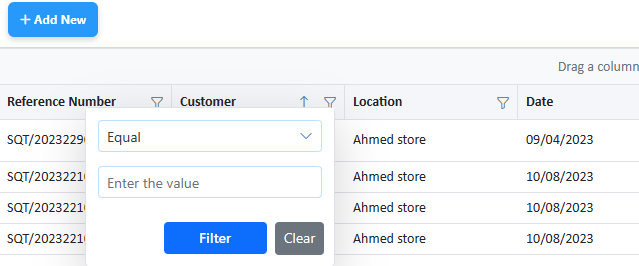
Click on the filter icon to open the filter, and enter the value to filter for or use the search bar to find the desired record.
The records can also be sorted in ascending and descending order of the desired field, simply double-click on the column that should be sorted.
Custom Grouping:

Drag the column to the bar to group the list by the column.


The system will display the information by groups.
Flow of Document Status
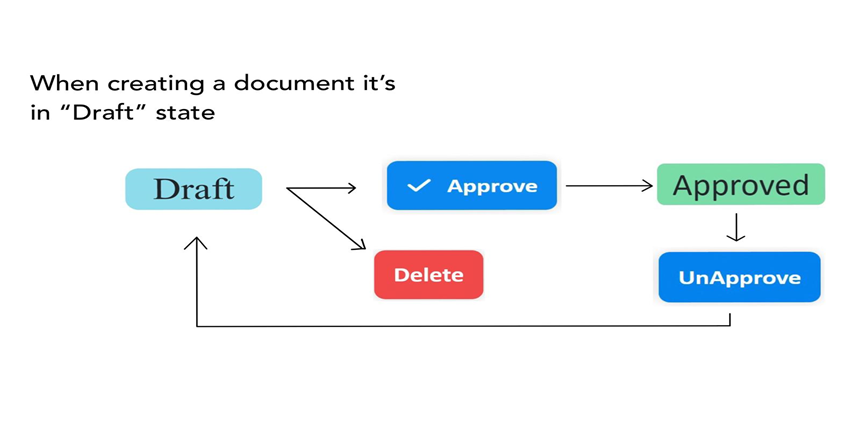
Note:

The document will be of closed status when the document is retrieved in another document.
How to create new a sale order.
Retrieving from Reference Option:
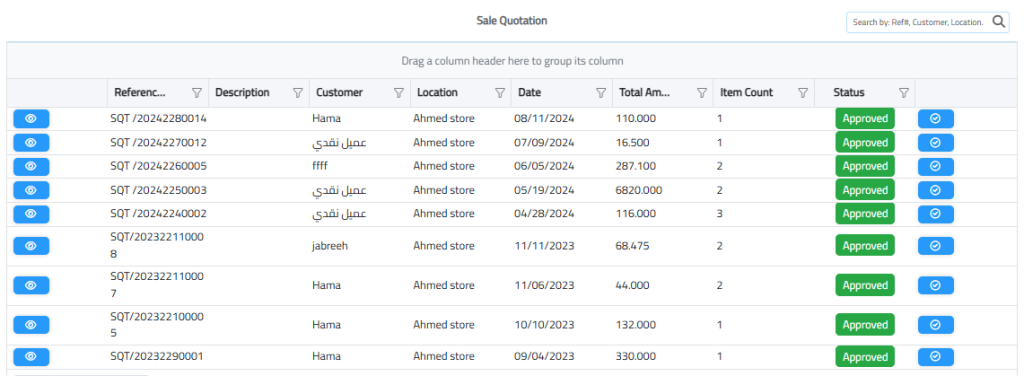
Search Button: Click the search button to retrieve from Sales Quotation entered in the module.

View Reference: To view a reference before choosing it, click the eye button.
OR, You can create a new sales order without the need of creating a sale quotation first.
Customer :

Select the customer.
Price List:

Once you select a customer, the linked price list will be displayed. However, it cannot be edited.
Location:

The Location to be targeted.
This cannot be edited once the product is selected.
These are the locations the user has access to under the current company.
Date:

Select the Date. Once the products are selected the date cannot be changed.
Currency

Select the desired currency.
Tax policy:

Choose the desired taxation policy.
Discount Type:

the discount types are of 2 kinds, discount by each item or by the entire invoice.


If it’s by type then enter how much discount amount per product in the table. And the system will do the calculations.
but if it is a discount by invoice then enter the discount Percentage.


Sale representative

The employee who has the responsibility of being a sales representative.
Price Retrieve Method:
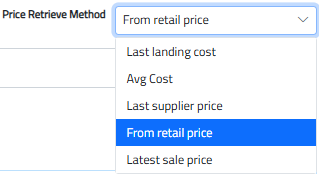
Choosing a price retrieval method affects how the price of a product or service is calculated and displayed transactions:
1. Last Landing Cost: This method retrieves the price from the most recent Goods Received Note (GRN), representing the latest cost at which the product was acquired.
2. Average Cost: This method calculates the price based on the average cost of the product over time, considering all previous purchase prices.
3. Last Price from Supplier: This method uses the most recent price provided by the supplier.
4. Retail Price: The retail price is the price specified in the product details at the time of its creation.
5. Last Sale Price: This method displays the price at which the product was last sold to customers, reflecting the most recent sale price.
The default method in sales quotation is retail price.
Description:

Enter the desired description.
Products:

Enter the product code directly or select it from a dropdown search for available products.

Latest cost will be shown to provide up-to-date pricing information.
Right-Click on a Line for More Actions:
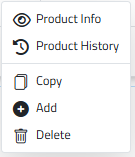
The Product History button displays all transactions for this particular product, including Incoming Quantity, Outgoing Quantity, and Difference Quantity.
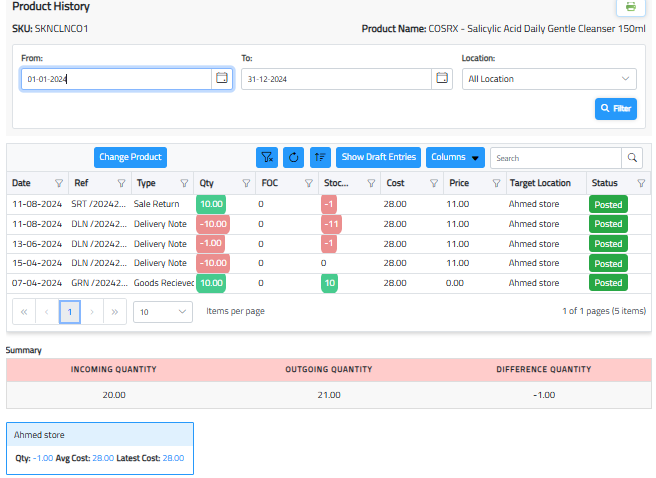
Once the products are selected, you cannot change the information below, Except : Discount, Sales representative and Description.
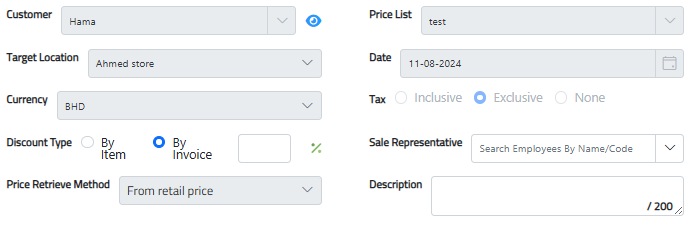
Actions:
| Click on the approve button to approve the document. |  |
| Click on the save button to create this Document. | |
| Click on the print button to export the document in PDF form. |  |
| To edit a approve document, user needs to un approve the document and make the necessary changes and approve the document again. |  |
| Once approved the user can easily make delivery note by clicking on the button. | |
| Click on the delete button to delete the document. |  |
Delivery Note
This page follows the creation of a sales order. It details the items being delivered to the customer, ensuring that the shipment matches the sales order and confirming receipt of the correct products.
Location Type determines the types of items you can include in the delivery note:

Filtering and Sorting:
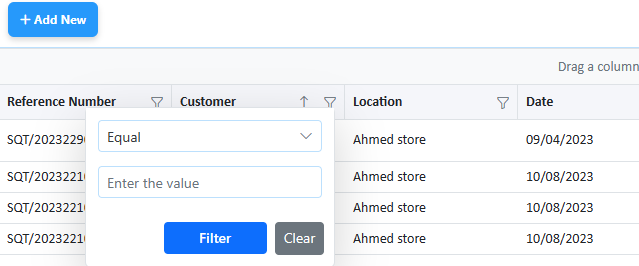
Click on the filter icon to open the filter, and enter the value to filter for or use the search bar to find the desired record.
The records can also be sorted in ascending and descending order of the desired field, simply double-click on the column that should be sorted.
Custom Grouping:

Drag the column to the bar to group the list by the column.


The system will display the information by groups.
Flow of Document Status
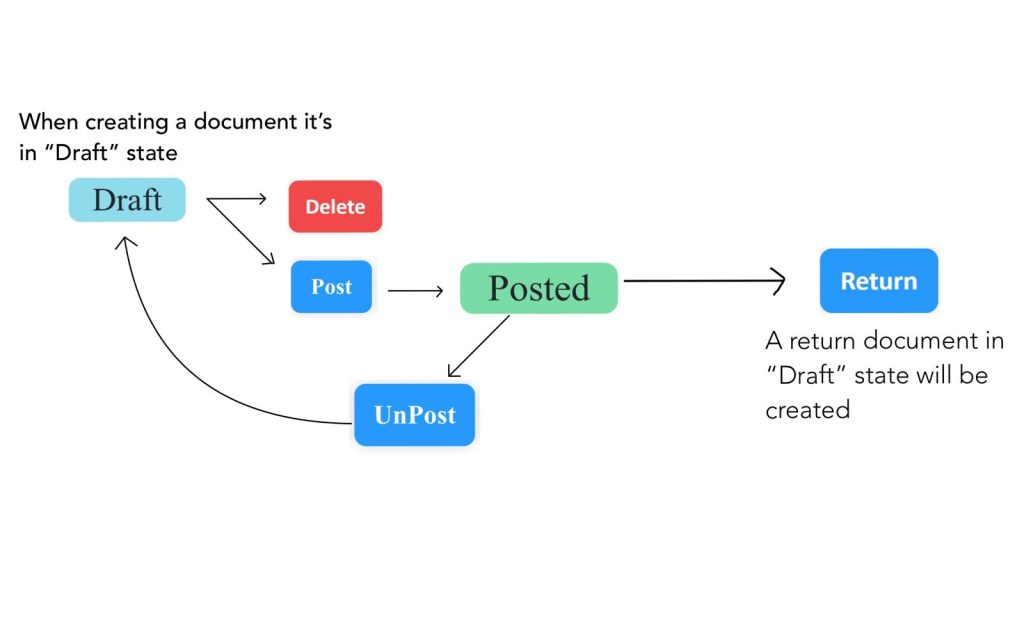
How to create new delivery note
Retrieving from Reference Option:
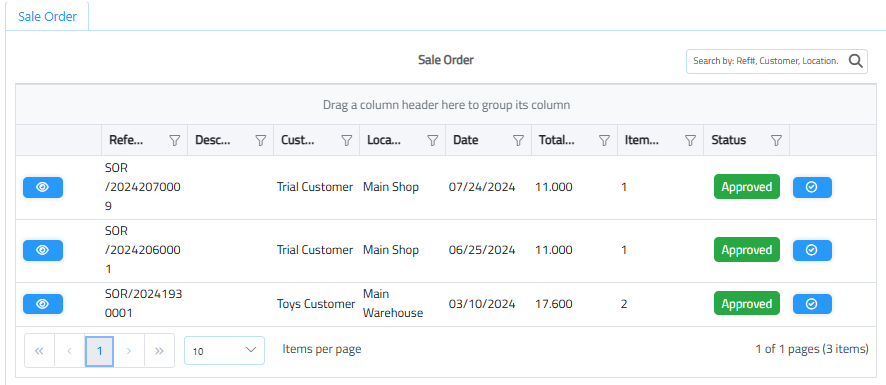
Search Button: Click the search button to retrieve from sale order entered in the module

View Reference: To view a reference before choosing it, click the eye button.
Customer :

Select the customer.
Price List:

Once you select a customer, the linked price list will be displayed. However, it cannot be edited.
Location:

The Location to be targeted.
This cannot be edited once the product is selected.
These are the locations the user has access to under the current company.
Date:

Select the Date. Once the products are selected the date cannot be changed.
Currency

Select the desired currency.
Tax policy:

Choose the desired taxation policy.
Discount Type:

the discount types are of 2 kinds, discount by each item or by the entire invoice.


If it’s by type then enter how much discount amount per product in the table. And the system will do the calculations.
but if it is a discount by invoice then enter the discount Percentage.


Sale representative

The employee who has the responsibility of being a sales representative.
Price Retrieve Method:
Choosing a price retrieval method affects how the price of a product or service is calculated and displayed transactions:
1. Last Landing Cost: This method retrieves the price from the most recent Goods Received Note (GRN), representing the latest cost at which the product was acquired.
2. Average Cost: This method calculates the price based on the average cost of the product over time, considering all previous purchase prices.
3. Last Price from Supplier: This method uses the most recent price provided by the supplier.
4. Retail Price: The retail price is the price specified in the product details at the time of its creation.
5. Last Sale Price: This method displays the price at which the product was last sold to customers, reflecting the most recent sale price.
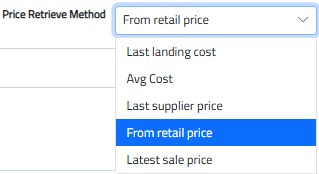
Once the products are selected, you cannot change the information below, Except : Discount, Sales representative and Description.
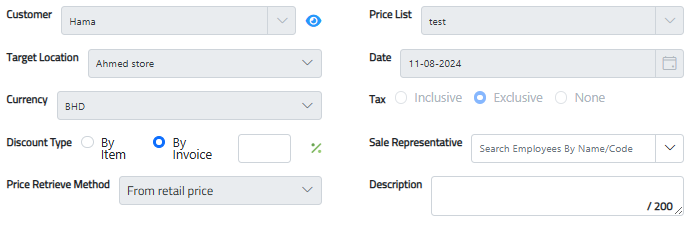
Expiry Date:

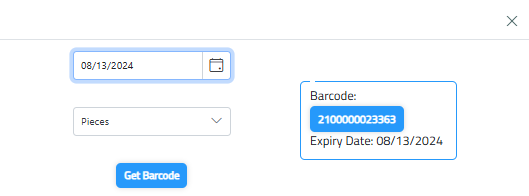
If you select a product with an expiration date, a message will appear, you have to click “Get Barcode” to continue using the product.
Actions:
| Click on the save button to create this Document. | |
| Click on the print button to export the document in PDF form. |  |
| Once approved the user can easily create a voucher by clicking on the button. and the system will will display a reference number in the bottom. | |
| the user can return a delivery note by clicking on the button. the system will create a credit note. | |
| If the user has permission, click the unpost button to unpost the document. | |
| Click on the delete button to delete the document. |  |
| Click the duplicate button to create a copy of the document. |
Delivery Note for Assets

This page helps to create document of the shipment of assets, detailing the items being delivered, including their descriptions and quantities, to verify the receipt of the specified assets by the recipient.
Retrieving from Reference Option:

Search Button: Click the search button to retrieve from sale order entered in the module.
View Reference: To view a reference before choosing it, click the eye button.
Customer :

Select the customer.
Location:

The Location to be targeted.
This cannot be edited once the product is selected.
These are the locations the user has access to under the current company.
Date:

Select the Date. Once the products are selected the date cannot be changed.
Currency

Select the desired currency.
Tax policy:

Choose the desired taxation policy.
Discount Type:

the discount types are of 2 kinds, discount by each item or by the entire invoice.


If it’s by type then enter how much discount amount per product in the table. And the system will do the calculations.
but if it is a discount by invoice then enter the discount Percentage.

Sale representative

The employee who has the responsibility of being a sales representative.
Products:

Enter the product code directly or select it from a dropdown search for available assets.
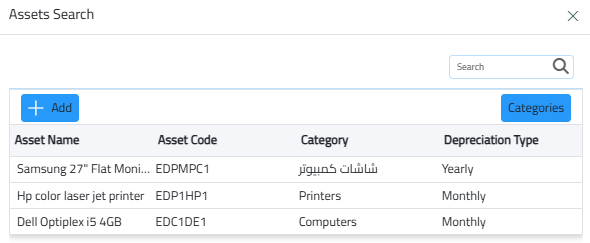
Right-Click on a Line for More Actions:
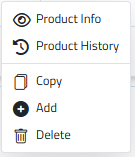
The Product History button displays all transactions for this particular product, including Incoming Quantity, Outgoing Quantity, and Difference Quantity.
Once the products are selected, you cannot change the information below, Except : Discount, Sales representative and Description.

| Click on the save button to create this Document | |
| If the user has permission, click the unpost button to unpost the document | |
| Click on the print button to export the document in PDF form. |  |
| Once approved the user can easily create a voucher by clicking on the button. and the system will will display a reference number in the bottom. | |
| the user can return a delivery note by clicking on the button. | |
| Click on the delete button to delete the document. |  |
Sales Return
This page is generated after the delivery note, if the customer returns any items. It manages the return process, adjusts inventory levels, and updates sales records to reflect the returned products.
Filtering and Sorting:
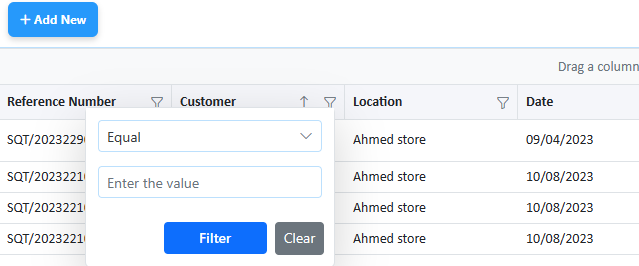
Click on the filter icon to open the filter, and enter the value to filter for or use the search bar to find the desired record.
The records can also be sorted in ascending and descending order of the desired field, simply double-click on the column that should be sorted.
Custom Grouping:

Drag the column to the bar to group the list by the column.


The system will display the information by groups.
Flow of Document Status
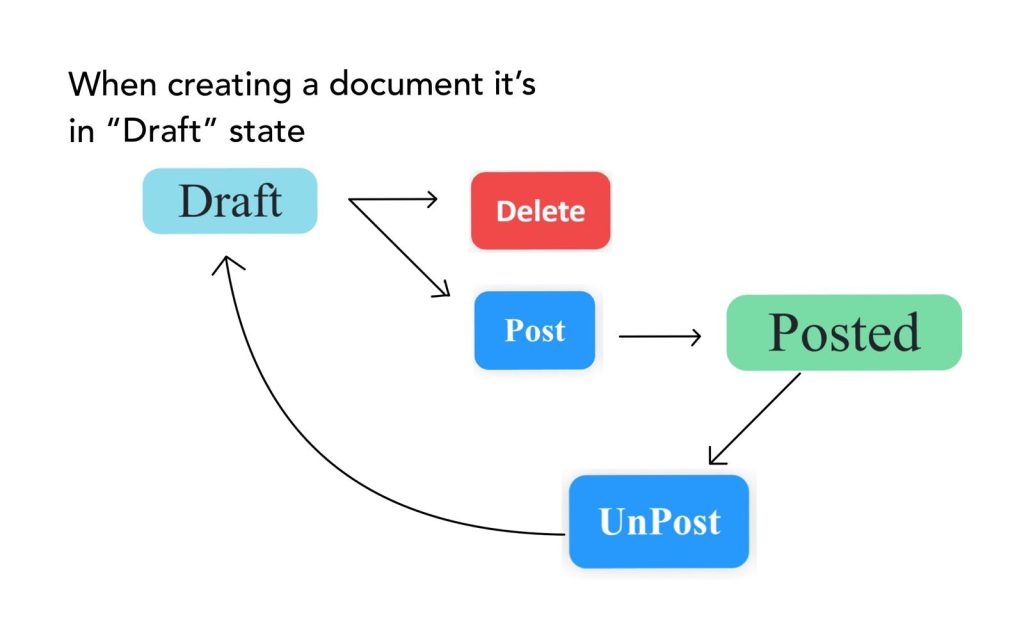
How to Create New Sales Return
Retrieving from Reference Option:

Search Button: Click the search button to retrieve from delivery note entered in the module.
View Reference: To view a reference before choosing it, click the eye button.
Customer :

Select the customer.
Price List:

Once you select a customer, the linked price list will be displayed. However, it cannot be edited.
Location:

The Location to be targeted.
This cannot be edited once the product is selected.
These are the locations the user has access to under the current company.
Date:

Select the Date. Once the products are selected the date cannot be changed.
Currency

Select the desired currency.
Tax policy:

Choose the desired taxation policy.
Discount Type:

the discount types are of 2 kinds, discount by each item or by the entire invoice.


If it’s by type then enter how much discount amount per product in the table. And the system will do the calculations.
but if it is a discount by invoice then enter the discount Percentage.


Sale representative

The employee who has the responsibility of being a sales representative.
Price Retrieve Method:

Choosing a price retrieval method affects how the price of a product or service is calculated and displayed transactions:
1. Last Landing Cost: This method retrieves the price from the most recent Goods Received Note (GRN), representing the latest cost at which the product was acquired.
2. Average Cost: This method calculates the price based on the average cost of the product over time, considering all previous purchase prices.
3. Last Price from Supplier: This method uses the most recent price provided by the supplier.
4. Retail Price: The retail price is the price specified in the product details at the time of its creation.
5. Last Sale Price: This method displays the price at which the product was last sold to customers, reflecting the most recent sale price.
The default method in sales quotation is retail price.
Description:

Enter the desired description.
Products:

Enter the product code directly or select it from a dropdown search for available products. Enter the returned qty.
Book Quantity: Refers to the stock quantity in the chosen unit.
Average Cost: Represents the cost in the chosen unit.
Amount: The total amount before applying taxes and discounts.
Right-Click on a Line for More Actions:
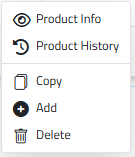
The Product History button displays all transactions for this particular product, including Incoming Quantity, Outgoing Quantity, and Difference Quantity.

Once the products are selected, you cannot change the information below, Except : Discount, Sales representative and Description.
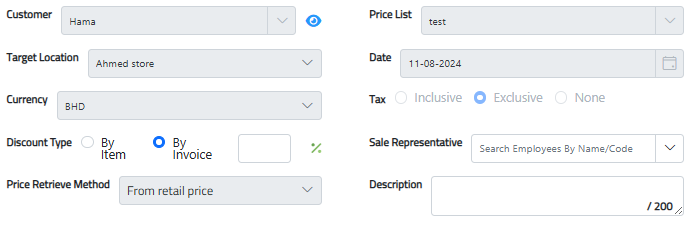
Actions:
| Click on the save button to create this Document. | |
| Click on the print button to export the document in PDF form. |  |
| Click the duplicate button to create a copy of the document. | |
| Once posting the voucher user can easily create a credit note by clicking on the button. and the system will display a reference number in the bottom. | |
| Click on the delete button to delete the document. |  |
Price Change Request
This page let employees request price changes, which managers then approve or reject. It keeps a record of all requests, ensuring accurate and authorized pricing updates.
Filtering and Sorting:

Click on the filter icon to open the filter, then enter the value to filter or use the search bar to find the desired record. Records can be sorted in ascending or descending order by double-clicking on the column header you wish to sort.
How to Create New Price Change Request
Retrieving from Reference:

Search Button: Click the search button to retrieve from Purchase Orders, Planned Purchase Orders, Goods Received Notes, or Supply Orders entered in the module.
It is preferable to choose the pricing group first, then specify if you want to get only new products, which are products that do not have prices in the selected group.


View Reference: To view a reference before choosing it, click the eye button.
Creating a New Change Price Request:
1. Price Group:

Select the price group from the drop-down menu. Ensure the price group is linked to a location (the affected location)
2. Price Type:
Choose from the price types added in the setup

Regular Price: Normal prices of the products without promotions and discounts
Promotion: Selecting this type will display the date range for the promotion.

Promotion Discount: Selecting this type will display the date range and discount type (by item or by invoice).

Permanent Discount: Selecting this type will display the discount type (by item or by invoice).

Date:

Enter the date for the entry. once products are selected, the date cannot be changed.
Description:

Enter a description for the entry “this will be an internal description, and it will not be printed”.
Products:
Enter the product code, or click on the search button to view all products.
Or, you have the option to search by supplier, supplier reference or category

After selecting a product, its current price will be displayed.

Enter the suggested price for the selected product.
Deleting a Product Line:
To delete a product line, select the product and click on Actions > Delete.

Actions:
| Click on the approve button to approve the document. |  |
| Click on the print button to export the document in PDF form. |  |
| To edit a approve document, user needs to un approve the document and make the necessary changes and approve the document again. |  |
| Click on the delete button to delete the document. |  |
POS Pricing Entry
POS pricing entry is the process of inputting and managing the prices of products sold at a retail location through a POS system. This allows businesses to efficiently handle pricing updates, discounts, and promotions, ensuring accurate pricing is applied at checkout and reflected in sales transactions.
Filtering and Sorting:

Click on the filter icon to open the filter, and enter the value to filter for or use the search bar to find the desired record.
The records can also be sorted in ascending and descending order of the desired field, simply double-click on the column that should be sorted.
Flow of Document Status :

How to Create POS Pricing Entry
Retrieving from Reference:

Search Button: Click the search button to retrieve from Purchase Orders, Planned Purchase Orders, Goods Received Notes, or Supply Orders entered in the module.
It is preferable to choose the pricing group first, then specify if you want to get only new products, which are products that do not have prices in the selected group.


View Reference: To view a reference before choosing it, click the eye button.
Creating a New POS pricing entries:
1. Price Group:

Select the price group from the drop-down menu. Ensure the price group is linked to a location (the affected location)
2. Price Type:
Choose from the price types added in the setup

Regular Price: Normal prices of the products without promotions and discounts
Promotion: Selecting this type will display the date range for the promotion.

Promotion Discount: Selecting this type will display the date range and discount type (by item or by invoice).

Permanent Discount: Selecting this type will display the discount type (by item or by invoice).

Date:

Enter the date for the entry. once products are selected, the date cannot be changed.
Description:

Enter a description for the entry “this will be an internal description, and it will not be printed”.
Products:
Enter the product code, or click on the search button to view all products.
Or, you have the option to search by supplier, supplier reference or category

After selecting a product, its previous price will be displayed.

Enter the suggested price for the selected product.
Deleting a Product Line:
To delete a product line, select the product and click on Actions > Delete.

Actions:
| Click on the approve button to approve the document. |  |
| Click on the print button to export the document in PDF form. |  |
| To edit a approve document, user needs to un approve the document and make the necessary changes and approve the document again. |  |
| Click on the delete button to delete the document. |  |
POS Invoices
POS Invoices are created when the shifts are closed in the POS module and the Z reports are generated.
Filtering and Sorting:

Click on the filter icon to open the filter and enter the value to filter for or use the search bar to find the desired record.

The records can also be sorted in ascending and descending order of the desired field, double-click on the column that should be sorted.
Double-click on the invoice the view detail:

Note: Enabling the “Update Inventory Stock” policy in POS Profiles page ensures that with each invoice payment, inventory is updated. For example, if a product is sold, the system will immediately adjust the stock quantity. You can track product movement but no stock will be adjusted until the shift is closed and pos invoice is posted.


You can create a voucher for POS invoices. The voucher reference number will appear at the bottom.

POS Adjustment:

You can create a POS adjustment only if there are negative quantities.

Click on the eye button to view the adjustment
Note: the adjustment will be system-generated and cannot be modified, as shown.

After creating an adjustment, you can then create a voucher. The voucher will be created in the Accounting module

Voucher reference number will display at the bottom.

Actions:
| Click on the Post button to create this Document. | |
| Click on the print button to export the document in PDF form. | |
| POS statement button will show all payments made, such as cash, credit card, and other payment methods used for that specific transaction. | |
| Click on the print button to export the document in PDF form. | |
| Click on the delete button to delete the document. |  |
